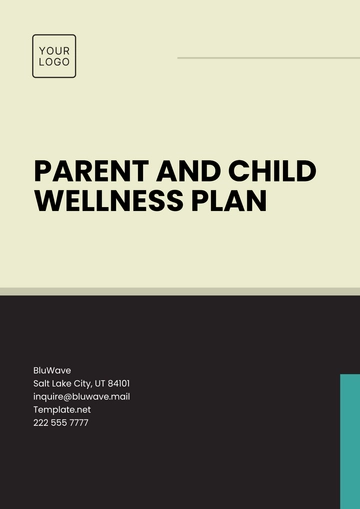Free Professional Teacher Wellness Plan

Prepared by: [Your Name]
Company: [Your Company Name]
Date: [Insert Date]
I. Introduction
Teaching is a rewarding yet challenging profession. Teachers are tasked with shaping the future while simultaneously managing their well-being. The Professional Teacher Wellness Plan aims to address the mental, physical, and emotional wellness of teachers by providing resources and strategies that support their overall health, productivity, and work-life balance. This plan is designed to enhance the well-being of teachers, ensuring they have the support needed to thrive in their roles.
II. Vision and Goals
Vision:
To create a supportive and sustainable work environment that prioritizes teacher wellness enhances job satisfaction, and fosters a positive impact on students and the school community.
Goals:
Enhance Physical Wellness: Promote regular physical activity, healthy eating, and overall health management to reduce stress and enhance energy levels.
Support Mental Health: Provide resources and support for mental well-being to manage stress, anxiety, and other challenges associated with the teaching profession.
Promote Emotional Resilience: Help teachers develop emotional resilience and coping strategies to navigate the demands of their work.
Encourage Professional Growth and Balance: Foster an environment that supports continued professional development while encouraging a balanced approach to work and personal life.
Create a Supportive Community: Build a strong, connected teacher community that offers peer support and mutual encouragement.
III. Key Areas of Focus and Strategies
A. Physical Wellness
Strategies:
Regular Physical Activity: Encourage teachers to participate in physical activities such as yoga, walking groups, or fitness classes to reduce stress and maintain physical health.
Healthy Eating Options: Provide nutritious meals in the school cafeteria and offer nutrition workshops to help teachers make healthier food choices.
Access to Health Resources: Ensure teachers have access to on-site wellness resources, such as health screenings, flu shots, and general health care services.
Fitness Incentives: Offer incentives or rewards for teachers who engage in physical activities, such as discounts for local fitness centers or group challenges.
Ergonomic Workspaces: Ensure that workspaces are designed to be ergonomically friendly, promoting proper posture and reducing physical strain during long hours.
B. Mental Health Wellness
Strategies:
Access to Counseling Services: Provide confidential counseling services for teachers to address mental health concerns, stress, and personal challenges.
Mental Health Awareness Campaigns: Conduct regular workshops or information sessions on mental health topics such as stress management, mindfulness, and self-care.
Stress Reduction Techniques: Offer stress-reduction programs, such as guided meditation, deep breathing exercises, or mindfulness activities, to help teachers manage daily pressures.
Workshops on Mental Health: Organize workshops focusing on coping strategies for dealing with burnout, trauma, and high-stress situations common in the classroom.
Peer Support Systems: Create peer mentoring or support groups where teachers can connect, share experiences, and support one another.
C. Emotional Wellness
Strategies:
Resilience Building Programs: Offer workshops on emotional resilience and how to maintain a positive mindset despite challenges.
Regular Check-Ins: Schedule regular check-ins with teachers to ensure their emotional well-being is supported and that they feel heard and valued.
Relaxation and Downtime: Encourage teachers to take regular breaks during their workday, providing designated areas for relaxation and recharging.
Employee Appreciation: Implement regular appreciation programs, where teachers are recognized for their hard work, achievements, and dedication.
Promote Positive Work Relationships: Foster a positive and supportive school culture that encourages open communication and strong relationships among colleagues.
D. Professional Development and Work-Life Balance
Strategies:
Professional Development Opportunities: Provide ongoing opportunities for teachers to attend workshops, conferences, and training programs that help them grow professionally while balancing their well-being.
Time Management Workshops: Offer time management and organizational skills workshops to help teachers manage their workloads and personal responsibilities more effectively.
Work-Life Balance Education: Hold seminars and discussions on achieving a healthy work-life balance, encouraging teachers to set boundaries between their professional and personal lives.
Flexible Scheduling: If possible, offer flexible work schedules or reduced teaching hours for teachers facing significant stress or life events.
Delegate and Share Responsibilities: Encourage collaborative teaching and team-building approaches, allowing teachers to delegate tasks and share responsibilities to avoid burnout.
E. Social Wellness and Community Building
Strategies:
Social Events and Networking Opportunities: Host regular social gatherings, such as faculty lunches, team-building activities, or happy hours, to help teachers connect and build supportive relationships.
Employee Resource Groups: Establish resource groups focused on shared interests, such as book clubs, fitness groups, or wellness teams, to foster a sense of community.
Peer Mentoring Programs: Create a mentoring program where experienced teachers provide guidance and support to new staff, helping them adjust and feel more connected to the school culture.
Celebrating Achievements: Celebrate teacher milestones such as years of service, retirement, or exceptional achievements in teaching, to promote a positive and supportive work environment.
Collaborative Projects: Encourage teachers to work on interdisciplinary projects, creating opportunities for collaboration and mutual support among colleagues.
IV. Implementation Plan
A. Roles and Responsibilities
Wellness Committee: Establish a wellness committee to oversee the implementation and monitoring of wellness initiatives and to gather feedback from teachers.
School Administration: Ensure support for wellness programs through funding, time allocation, and creating a wellness-friendly school environment.
Human Resources and Counseling Services: Provide counseling, mental health resources, and wellness activities for teachers and staff.
Teachers: Actively participate in wellness programs, share feedback, and encourage colleagues to engage in wellness initiatives.
Peer Leaders and Wellness Ambassadors: Empower select teachers to serve as wellness ambassadors who encourage participation and serve as points of contact for wellness initiatives.
B. Timeline
Phase 1 (Month 1-3): Establish a wellness committee, conduct surveys to assess teachers' needs, and launch physical wellness programs (e.g., fitness classes, health screenings).
Phase 2 (Month 4-6): Roll out mental health initiatives, including counseling services, workshops on stress management, and emotional wellness programs.
Phase 3 (Month 7-12): Expand professional development offerings, introduce work-life balance programs, and establish peer support networks.
Phase 4 (Ongoing): Continuously evaluate wellness programs through teacher feedback, surveys, and focus groups to improve and adapt initiatives to meet teachers' evolving needs.
V. Measurement and Evaluation
A. Key Performance Indicators (KPIs)
Participation Rates: Track the number of teachers participating in wellness programs such as fitness classes, workshops, and counseling services.
Wellness Surveys: Conduct annual surveys to measure teacher satisfaction with wellness programs and identify areas for improvement.
Teacher Retention Rates: Monitor retention rates as an indicator of overall job satisfaction and well-being.
Teacher Feedback: Collect qualitative feedback through focus groups and interviews to understand the effectiveness of wellness initiatives and the impact on teacher well-being.
B. Evaluation Methods
Regular Surveys: Conduct surveys twice a year to assess teacher satisfaction with wellness resources and identify any gaps or areas for improvement.
Focus Groups: Hold focus groups with teachers to discuss the effectiveness of wellness initiatives and explore additional support needed.
Ongoing Feedback Mechanisms: Provide teachers with anonymous feedback opportunities throughout the year to voice their opinions on wellness programs.
VI. Sustainability Plan
Ongoing Funding: Ensure funding for wellness programs through school budgets, fundraising, or community partnerships.
Teacher Leadership: Encourage teachers to take leadership roles in wellness initiatives, helping to promote and sustain wellness activities.
Partnerships with Local Organizations: Collaborate with local wellness providers, healthcare centers, and fitness organizations to offer discounted services and resources for teachers.
Program Evolution: Regularly update wellness programs based on teacher feedback, emerging wellness trends, and the changing needs of the teaching profession.
VII. Conclusion
The Professional Teacher Wellness Plan is designed to support teachers in all aspects of their well-being, ensuring they are physically, mentally, and emotionally equipped to succeed in their demanding roles. By providing a comprehensive approach to wellness, fostering a supportive community, and promoting work-life balance, this plan aims to create a sustainable, positive work environment where teachers can thrive. A well-supported teacher workforce ultimately leads to better educational outcomes for students, making teacher wellness a critical component of any school’s success.
- 100% Customizable, free editor
- Access 1 Million+ Templates, photo’s & graphics
- Download or share as a template
- Click and replace photos, graphics, text, backgrounds
- Resize, crop, AI write & more
- Access advanced editor
You may also like
- Finance Plan
- Construction Plan
- Sales Plan
- Development Plan
- Career Plan
- Budget Plan
- HR Plan
- Education Plan
- Transition Plan
- Work Plan
- Training Plan
- Communication Plan
- Operation Plan
- Health And Safety Plan
- Strategy Plan
- Professional Development Plan
- Advertising Plan
- Risk Management Plan
- Restaurant Plan
- School Plan
- Nursing Home Patient Care Plan
- Nursing Care Plan
- Plan Event
- Startup Plan
- Social Media Plan
- Staffing Plan
- Annual Plan
- Content Plan
- Payment Plan
- Implementation Plan
- Hotel Plan
- Workout Plan
- Accounting Plan
- Campaign Plan
- Essay Plan
- 30 60 90 Day Plan
- Research Plan
- Recruitment Plan
- 90 Day Plan
- Quarterly Plan
- Emergency Plan
- 5 Year Plan
- Gym Plan
- Personal Plan
- IT and Software Plan
- Treatment Plan
- Real Estate Plan
- Law Firm Plan
- Healthcare Plan
- Improvement Plan
- Media Plan
- 5 Year Business Plan
- Learning Plan
- Marketing Campaign Plan
- Travel Agency Plan
- Cleaning Services Plan
- Interior Design Plan
- Performance Plan
- PR Plan
- Birth Plan
- Life Plan
- SEO Plan
- Disaster Recovery Plan
- Continuity Plan
- Launch Plan
- Legal Plan
- Behavior Plan
- Performance Improvement Plan
- Salon Plan
- Security Plan
- Security Management Plan
- Employee Development Plan
- Quality Plan
- Service Improvement Plan
- Growth Plan
- Incident Response Plan
- Basketball Plan
- Emergency Action Plan
- Product Launch Plan
- Spa Plan
- Employee Training Plan
- Data Analysis Plan
- Employee Action Plan
- Territory Plan
- Audit Plan
- Classroom Plan
- Activity Plan
- Parenting Plan
- Care Plan
- Project Execution Plan
- Exercise Plan
- Internship Plan
- Software Development Plan
- Continuous Improvement Plan
- Leave Plan
- 90 Day Sales Plan
- Advertising Agency Plan
- Employee Transition Plan
- Smart Action Plan
- Workplace Safety Plan
- Behavior Change Plan
- Contingency Plan
- Continuity of Operations Plan
- Health Plan
- Quality Control Plan
- Self Plan
- Sports Development Plan
- Change Management Plan
- Ecommerce Plan
- Personal Financial Plan
- Process Improvement Plan
- 30-60-90 Day Sales Plan
- Crisis Management Plan
- Engagement Plan
- Execution Plan
- Pandemic Plan
- Quality Assurance Plan
- Service Continuity Plan
- Agile Project Plan
- Fundraising Plan
- Job Transition Plan
- Asset Maintenance Plan
- Maintenance Plan
- Software Test Plan
- Staff Training and Development Plan
- 3 Year Plan
- Brand Activation Plan
- Release Plan
- Resource Plan
- Risk Mitigation Plan
- Teacher Plan
- 30 60 90 Day Plan for New Manager
- Food Safety Plan
- Food Truck Plan
- Hiring Plan
- Quality Management Plan
- Wellness Plan
- Behavior Intervention Plan
- Bonus Plan
- Investment Plan
- Maternity Leave Plan
- Pandemic Response Plan
- Succession Planning
- Coaching Plan
- Configuration Management Plan
- Remote Work Plan
- Self Care Plan
- Teaching Plan
- 100-Day Plan
- HACCP Plan
- Student Plan
- Sustainability Plan
- 30 60 90 Day Plan for Interview
- Access Plan
- Site Specific Safety Plan





























